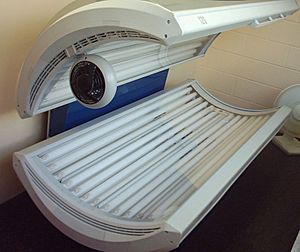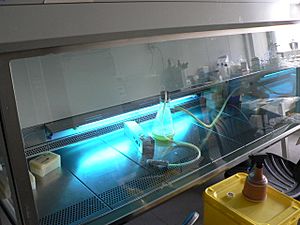Ultraviolet facts for kids
Ultraviolet (UV) is a type of light energy that is part of the electromagnetic spectrum, just like the visible light we see every day, radio waves, or X-rays. It has shorter wavelengths and more energy than visible light.
Contents
- Ultraviolet radiation
- Where does UV come from?
- The energy of UV light
- Types of UV
- How the Earth's atmosphere protects us
- Can humans see UV light?
- History of discovery
- Effects on human health
- Protecting yourself from UV
- UV and materials
- Cool uses of UV light
- Interesting facts about UV light
- Images for kids
- See also
Ultraviolet radiation
Ultraviolet radiation, often called UV, is a form of energy that travels in waves. Think of it like ripples on a pond, but much, much smaller and faster. These waves are part of a big family of energy waves called the electromagnetic spectrum. Visible light, the light we see that makes up colors like red, orange, yellow, green, blue, indigo, and violet, is also part of this family.
UV waves are shorter than the waves of visible light. The word "ultraviolet" actually means "beyond violet," because violet is the color with the shortest wavelength that humans can see. UV waves are just beyond that.
Where does UV come from?

The most common source of UV radiation is the Sun. About 10% of the total energy the Sun sends out is UV light. But UV isn't just from the Sun. It can also be made by special lights, like:
- Black lights: These make things glow.
- Tanning lamps: Used in tanning beds.
- Mercury-vapor lamps: Used in streetlights and other places.
- Electric arcs: Like those made during welding.
The energy of UV light
UV light waves carry more energy than visible light waves. This extra energy is why UV can cause chemical reactions and affect living things in ways that visible light doesn't. For example, it can make certain materials glow (this is called fluorescence) or even damage tiny parts of cells, like DNA.
Types of UV
Scientists divide UV radiation into different types based on their wavelength and energy. The main types are:
- UVA: This has the longest wavelengths (315 to 400 nanometers). It has the least energy of the UV types. Most of the UV that reaches the Earth's surface is UVA.
- UVB: This has medium wavelengths (280 to 315 nanometers). It has more energy than UVA. A smaller amount of UVB reaches the Earth's surface compared to UVA.
- UVC: This has the shortest wavelengths (100 to 280 nanometers). It has the most energy and is the most dangerous type of UV.
How the Earth's atmosphere protects us
The Earth's atmosphere acts like a shield against most of the Sun's UV radiation.
- Oxygen: The shortest, most energetic UVC rays are almost completely absorbed by oxygen high up in the atmosphere. This process also helps create the ozone layer.
- The Ozone layer: This special layer in the atmosphere is made of ozone gas. It's super important because it absorbs most of the dangerous UVB rays and any remaining UVC rays. Without the ozone layer, life on land would be very difficult because the UV radiation would be too strong.
- Clouds and air: Clouds and even the air itself (through something called Rayleigh scattering, which also makes the sky look blue) can scatter and absorb some UV radiation, but they don't block it completely. You can still get sunburned on a cloudy day.
Because of this atmospheric protection, almost all the UV that reaches the ground is UVA (over 95%), with a small amount of UVB. Almost no UVC reaches us from the Sun.
Can humans see UV light?
Generally, no. Human eyes are designed to see visible light. The lens in our eye blocks most UV light from reaching the back of the eye (the retina). This is a good thing, as too much UV can damage the eye. However, some animals, like birds, insects (like bees), and some mammals, can see near-UV light. This helps them find food (like flowers with UV patterns) or navigate.
History of discovery
UV radiation was discovered way back in 1801 by a German scientist named Johann Wilhelm Ritter. He was experimenting with light and noticed that invisible rays just beyond the violet end of the visible light spectrum made a special paper turn dark faster than violet light did. He called them "chemical rays" at first because of this reaction. Later, scientists started calling them "ultraviolet" because they were "beyond violet."
Scientists learned more about UV over time:
- 1878: The idea that short-wavelength light could kill bacteria was discovered.
- 1903: Scientists figured out that wavelengths around 250 nanometers were best for killing germs.
- 1960: The effect of UV on DNA was established.
- 1932: The different types of UV (UVA, UVB, UVC) were officially classified by scientists at a meeting in Copenhagen.
Effects on human health
UV radiation has both helpful and harmful effects on people.
Beneficial effects
- Vitamin D production: This is a really important one! When your skin is exposed to UVB rays, it makes Vitamin D. Vitamin D is essential for strong bones and overall health. Just a little bit of sun exposure (like 5-15 minutes a few times a week during sunny months) is usually enough for your body to make the Vitamin D it needs. You can also get Vitamin D from certain foods and vitamins.
- Mood: Sunlight exposure, which includes UV, can help your body produce serotonin, a chemical that can make you feel happy and calm.
- Skin condition treatment: Doctors sometimes use special UV light therapy to treat certain skin problems like psoriasis or eczema.
Harmful effects
Getting too much UV exposure can be bad for your health.
- Sunburn: This is the most common and immediate effect of too much UV, especially UVB. It's your skin's way of telling you it's been damaged.
- Skin damage and aging: Both UVA and UVB can damage the fibers in your skin that keep it firm and smooth (like collagen). This can make your skin wrinkle and look older faster.
- Skin cancer: This is a serious risk of getting too much UV exposure over time. UVB can directly damage your DNA, which can lead to skin cancer. UVA can also contribute to skin cancer by causing indirect damage. The most serious type is called melanoma. Protecting your skin from too much sun is very important to lower this risk.
- Eye damage: UV can hurt your eyes. Too much exposure can cause a painful condition like "snow blindness" (photokeratitis) or lead to long-term problems like cataracts (clouding of the eye's lens) or growths on the eye. Wearing sunglasses that block UV is a good idea, especially in bright sun or around reflective surfaces like snow or water.
Protecting yourself from UV
Since too much UV can be harmful, it's important to protect yourself:
- Sunscreen: Sunscreen has special ingredients that absorb or block UV rays. SPF (Sun Protection Factor) tells you how well it blocks UVB. Look for "broad-spectrum" sunscreen, which blocks both UVA and UVB. Remember to put it on correctly and reapply it, especially after swimming or sweating.
- Protective clothing: Wearing clothes, hats, and sunglasses can block UV rays from reaching your skin and eyes. Some clothing even has a UPF (Ultraviolet Protection Factor) rating.
- Seek shade: Staying in the shade, especially during the middle of the day when the Sun's UV rays are strongest, is a great way to reduce your exposure.
UV and materials
UV light doesn't just affect living things; it can also affect materials:
- Degradation: UV can break down certain materials, especially plastics, paints, and fabrics. This can cause them to fade, crack, or lose strength over time. This is why things left outside in the sun can get damaged. Special chemicals called UV absorbers can be added to materials to help protect them.
- Fluorescence: Many substances glow or fluoresce when UV light shines on them. This happens because the UV energy is absorbed and then re-emitted as visible light. This is how black lights work!
Cool uses of UV light
Because of its unique properties, UV light is used in many interesting ways:
- Sterilization and disinfection: UVC light is very good at killing germs like bacteria and viruses because it damages their DNA. It's used to sterilize equipment in hospitals and labs, and to disinfect water and air.
- Forensics: At crime scenes, UV lights can help investigators find things that aren't easily seen in visible light, like certain bodily fluids or fingerprints treated with fluorescent powders.
- Checking money and documents: Many currencies and official documents have hidden marks or threads that only show up under UV light, helping to prevent counterfeiting.
- Curing materials: UV light can make certain glues, inks, and coatings harden very quickly. This is used in everything from dental fillings to printing and manufacturing.
- Bug zappers: Some bug zappers use UV light to attract insects.
- Analyzing materials: Scientists use UV light to study the makeup of different substances, like chemicals or minerals.
- Astronomy: Telescopes in space use UV detectors to study stars and galaxies, as many objects in space emit UV light that is blocked by Earth's atmosphere.
- Manufacturing: UV is used in making tiny electronic parts like computer chips (this is called photolithography).
Interesting facts about UV light
- Some animals see UV, which helps them find food or recognize each other.
- UVB can affect how plants grow and develop.
- Scorpions are famous for glowing under UV light!
- Scientists believe that UV radiation played a role in the early evolution of life by causing changes (mutations) in DNA, which led to the development of DNA repair systems.
Ultraviolet radiation is a fascinating part of the light spectrum with a wide range of effects, from helping our bodies make Vitamin D to being used in advanced technology and even playing a role in the history of life on Earth. Understanding UV helps us appreciate its power and learn how to use it safely and effectively.
Images for kids
-
UV damaged polypropylene rope (left) and new rope (right)
-
IR spectrum showing carbonyl absorption due to UV degradation of polyethylene
-
Aurora at Jupiter's north pole as seen in ultraviolet light by the Hubble Space Telescope.
See also
 In Spanish: Radiación ultravioleta para niños
In Spanish: Radiación ultravioleta para niños












